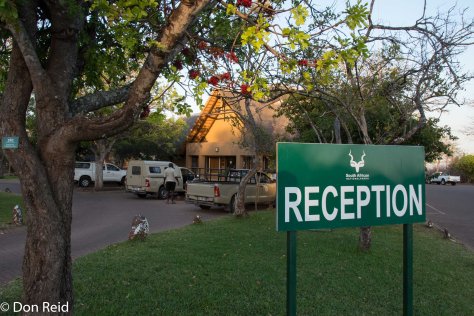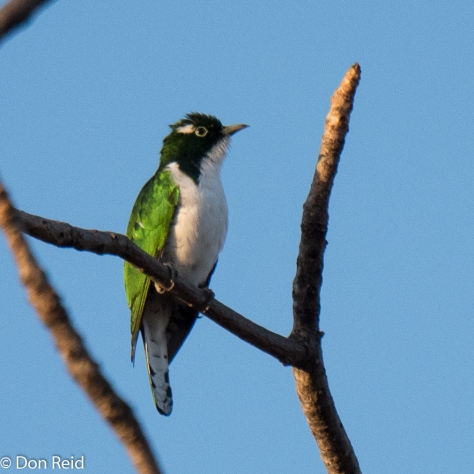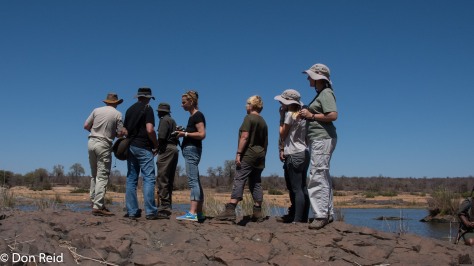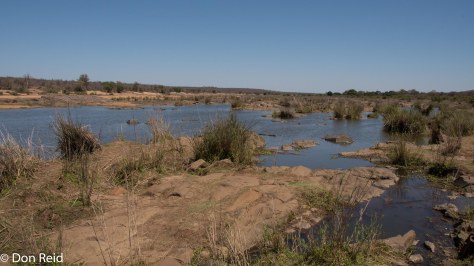For the second year in a row we spent a week in Kruger National Park in October, this time spending 6 nights in Olifants rest camp in the northern part of Kruger, with one night stop-overs at Berg en Dal and Pretoriuskop rest camps on the way there and back respectively.
There are two basic options when you plan a week’s stay in Kruger – spend two nights each in say three of the rest camps or book the whole week in one camp. Both options have pros and cons, but I must say our preference nowadays is the latter which means less travelling and more relaxing. It becomes less urgent to take a game drive every day, particularly when the camp itself offers “add-ons” such as swimming pools, decent coffee shop/restaurant, activities such as bush walks and of course the potential birding on offer in the camp itself.
Olifants camp has all of the above and the added advantages of its location on top of a ridge, with its famous viewpoint overlooking the Olifants river far below and stretching to the horizon in an unbroken vista of pristine bushveld, one of the finest spots in Kruger and one that has remained unchanged for the four decades that we have been visiting it.



Recovery Time
Two full days of driving for Gerda and myself, three for Andre and Geraldine and the girls, meant our first day in Olifants was a recovery day and the unseasonably chilly, very windy conditions were in any case not conducive to pleasant game watching and bird-spotting. So we spent the whole day in camp, alternating between walks, eating and enjoying tea and coffee breaks.

A trip to the restaurant for milkshakes was the treat of the day for the kids (young and old ones) followed by an “Ellie-roll” prepared at our rondavels – bacon and egg on a bun with fried onions and avo, plus beans on the side – it has to be prepared in Olifants camp to earn its name, otherwise it’s just a breakfast bun.


A morning birding walk around the camp added a few new birds to our trip list, among them Yellow-bellied Greenbul, Chinspot Batis, Amethyst Sunbird, White-bellied Sunbird and Crested Barbet, all of which are fairly easy to spot in the camp.




Hornbills for Africa
On another morning I had some fun photographing the almost ever-present Hornbills in the trees and on the ground around the rondavels, both Yellow-billed and Red-billed species. They are ridiculously easy to photograph, the only challenge is getting a different view of them and not just settling for the “posing on a branch” shot. I tried getting down to ground level for some of the photos, which worked quite well




Late one afternoon I came across this individual who had clearly been taking a dust bath…..


Short Drives around Olifants
One option for a shorter drive from Olifants is the circular route that follows the S44 outbound and returns on the S93 and this was our chosen route early one morning.

The frequent river views had enough game and other interesting sights to keep us alert and the birding proved to be excellent with the likes of Common Scimitarbill, Paradise Flycatcher, Red-headed Weaver, Grey Tit-Flycatcher and Little Bee-eater making their presence known.
A longer stop at the viewpoint, where you can get out of the car (whilst still keeping an eye out for wild animals of course), meant we could enjoy a tea and snacks – the genuine Kruger Park kind being two Provita biscuits with cheese wedges carefully squashed in between – the staple food of hiking trips.



As we were standing around with our mugs of tea, a different looking bird caught my eye – it turned out to be a White-throated Robin-Chat, which sat obligingly still so that I could photograph it from close quarters.

At the same time a very tame squirrel (suspiciously so – had he been drinking?) decided to entertain us, worrying Geraldine and even jumping onto my leg at one stage – no idea what he was thinking, it’s not as if I had some nuts hidden in my shorts.

Later on the same day we headed out on a short drive to Balule camp and back, along the S92, spending time at the several river viewpoints and on the low water bridge at Balule, taking in the classic river scenes in the soft late afternoon light – “golden hour” for photographers.


The short route had plenty of interest, from Waterbuck to White-fronted Bee-Eaters. A displaying Red-crested Korhaan entertained us briefly with its vertical flight and tumbling fall back to earth, while a Green-backed Heron put in an appearance at the bridge, moments after Andre predicted seeing one there – with some training this boy will go far!


River Walk from Olifants
Nowadays there is a selection of activities available from most of Kruger’s camps and we decided to do the mid-morning River walk along a stretch of the Letaba river not far from the camp. On checking in for the walk we discovered we were to be bit-part actors in a promotional video and had to “pose” here and there.

The guides drove to the starting point at a low water bridge accessed via a “no-entry” road. Along the way a pair of African Hawk-Eagles soared overhead and at the bridge we could spot African Jacana, Black Crake, Wire-tailed Swallows and a swooping African Harrier-Hawk.
The walk started at the bridge and we headed in single file down the river (or was it up?) our guides in front, stopping frequently for lessons in the various aspects of the surroundings including animal droppings – a science in itself it seems, river vegetation, trees, freshwater mussels and skeletal remains of animals such as Hippo and Buffalo.


Birds along the river included Goliath and Grey Herons, African Openbill, Egyptian Goose (of course) and Spoonbills. Calls emanating from the riverine bush belonged to Grey-headed Bushshrike, Black-headed Oriole and some noisy Tawny-flanked Prinias amongst the longer grasses.

We purposely skirted around two lone Buffaloes – called “dagha-boys” for reasons which guide Patrick explained nicely – one of which watched us curiously as we ambled past. Hippos were seen at a distance and Waterbuck and Impalas scattered at our approach. The walk was not particularly strenuous and it wasn’t long before we turned around and headed back to the vehicle, well pleased that we had booked for this outing.


And the Baboons…….
Well they, along with the monkeys, are a real nuisance around the rest camp. On checking in at Reception they do warn you to keep your edibles inside and windows closed when not around, but these crafty animals find ways of getting what they want – grabbing goodies from vehicles while you unpack, opening cupboards on the stoep and even rummaging in the dustbins which are kept in a small enclosure behind a metal gate, which they simply jump over as it is not enclosed on the top.

They also rate as some of the most aggressive animals I have come across, growling at me when I confronted them as they were busy trashing our neighbouring rondavel’s provisions. The only deterrent is a good old cattie (catapult) – they scatter at the sight of it!

Most interesting post, Donald!
Thanks Michele